Eucalyptus trees are among the most popular evergreen trees native to Australia where they are commonly referred to as gum trees or stringybark trees.
Eucalyptus trees are widely cultivated throughout many places around the world from Africa, Asia, Europe, South America to North America. They grow quickly and easily wherever there is sufficient rainfall. They are generally planted as shade trees, windbreaks and in forestry plantations.
Let’s look at different types of Eucalyptus trees from small to large trees together with their characteristics, advantages and disadvantages.
Characteristics of Eucalyptus
- Eucalyptus leaves are gray-green or blue-green, usually oval and tough in texture when mature. Juvenile leaves on young trees are blue, round and unstalked. The leaves emit a camphor-like scent.
- Flowers look like tassels of stamens, opening a year after buds are formed.
- The bark is usually smooth, white to cream-colored.
- Many eucalyptus trees shed the dead outermost layer of bark in flakes or ribbons whereas other varieties or types have thick textured bark.
- Eucalyptus mature height depends on the species, which range from shrubs to small and tall trees, generally between 10-200 feet tall.
- Eucalyptus trees don’t share space well with other type of trees. They quickly absorb nutrients and water from the soil leaving other plants thirsty and malnourished.
- Large Eucalyptus dumps lots of leaves and bark on the ground.
- They can live up to 100 years.
- Many eucalyptuses grow as fast as 7-10 feet per year.
- The trees are easily grown from seed and tolerate dry, sandy and salty soils.
- The eucalyptus timber is yellow-brown, fairly heavy with an interlocked grain.
- These trees are generally filled with volatile aromatic oil, which makes them highly combustible.
- Eucalyptus does well in soils with average moisture and tolerates a high pH.
List of Eucalyptus Trees In North America
- Eucalyptus baby blue
- Tasmanian alpine yellow gum
- Rainbow Eucalyptus
- Cider Gum
- Silver Princess Gum
- Lemon Scented Gum
- Silver Dollar Eucalyptus
- Sugar Gum
- Moort Eucalyptus
- Mountain Gum
- Spinning Gum
- Plunkett Mallee
- River Red Gum
- Alpine Ash
- Shinning Gum
- Weeping Snow Gum
- Sydney Blue Gum
- Ribbon Gum
Description
Eucalyptus baby blue
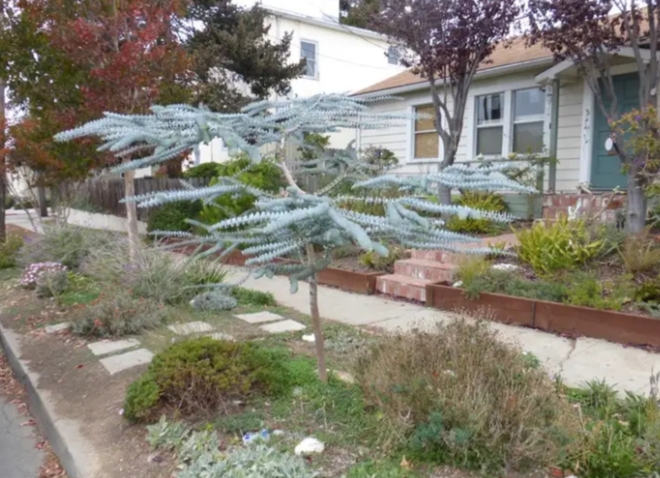
Scientific Name: Eucalyptus pulverulenta
Other Names: Florist Silver Dollar
Size: This eucalyptus grows between 10 and 14 feet under the right conditions.
Characteristics: This is a small evergreen tree or sprawling shrub with open, spreading habit that retains its juvenile foliage into maturity. The leaves are small, blue-green in color. Both the leaves and stems have a very strong aroma. Flowers are white and appear in winter and spring. This eucalyptus offers a picturesque look in rock or small gardens.
Tasmanian alpine yellow gum
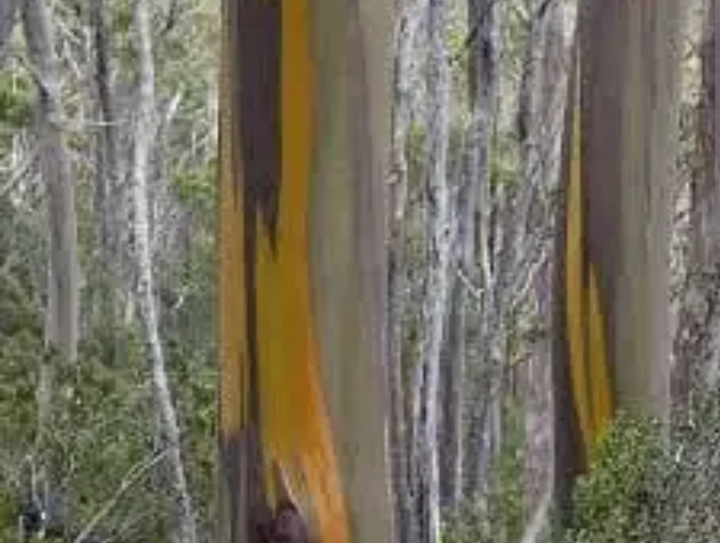
Scientific Name: Eucalyptus Johnstonii
Size: This is a medium-sized tree typically growing between 40 and 115 feet in height.
Characteristics: Tasmanian alpine yellow gum is easily identifiable by just looking at its bark. The bark is smooth, yellow to greenish in color with fibrous bark near the base. The leaves appear somehow curved in shape and are glossy green on both sides. Flowers are white and appear in winter and spring. It is usually an ideal tree for woodland and arboreta plantings.
Rainbow Eucalyptus
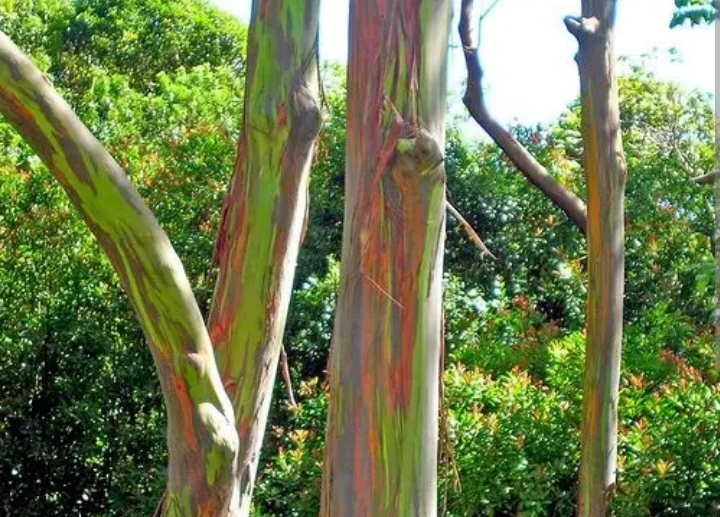
Scientific Name: Eucalyptus deglupta
Other Names: Mindanao gum
Size: Rainbow eucalyptus can reach over 150 feet tall, though in many places in North America, these trees average 100 feet.
Characteristics: Rainbow eucalyptus is the most beautiful tree in the world of eucalyptus. It is characterized by multi-colored bark- its outer bark delicately peels and reveals the inner bark in streaks of pale green, orange, gray, red pastel blue and sunset pink hues.
The leaves are spear-shaped, silvery-green whereas the flowers are tiny and appear in clusters. It is a good specimen tree for wider landscape, arboretum collection or very large garden.
Cider Gum

Scientific Name: Eucalyptus gunii
Size: Cider gum typically grow between 25 and 80 feet depending with growing conditions.
Characteristics: This is a hardy evergreen tree with peeling bark in shades of grey, cream, green and brown. It is also characterized by silver-blue leaves when young and blue-green at maturity. During summer creamy white flowers with many stamens appear on branches. This gum tree has earnt a Royal Horticultural Society Award of Garden Merit.
Silver Princess Gum
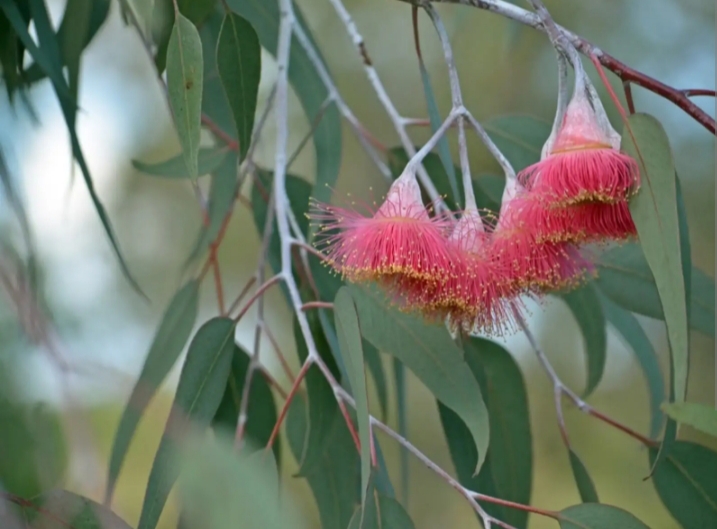
Scientific Name: Eucalyptus caesia
Size: This tree grows between 6 and 30 feet in height and has a lifespan of at least 60 years. The plant can reach a maximum width of about 3m.
Characteristics: Silver princess is characterized powdery blue-green foliage on weeping branches, shimmering silver bark and pink-red flowers consisting of yellow anthers in the winter or early spring. This tree works best in creating a focal point in large gardens or as a backyard tree.
Lemon Scented Gum
Scientific Name: Corymbia citriodora
Size: Lemon scented gum generally grows between 30 and 110 feet tall and 6-12 feet wide.
Characteristics: It is a tree with an upright growing habit, consisting of a straight trunk and a thin crown of drooping foliage. The foliage is green, long and slender with an amazing strong lemon fragrance when crushed. The trunk and large branches have smooth powdery bark that often sheds in curling flakes from later summer to fall.
Silver Dollar Eucalyptus
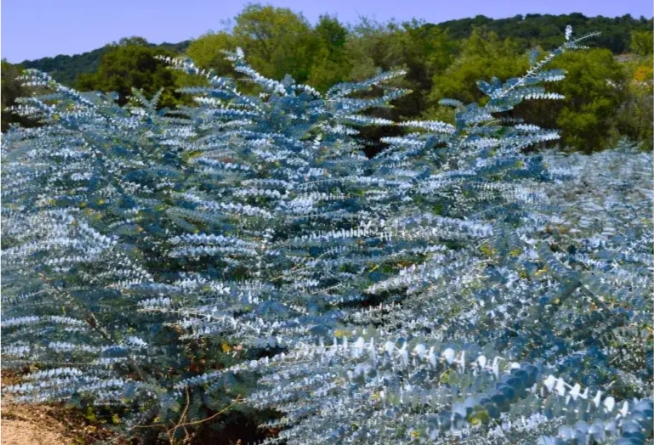
Scientific Name: Eucalyptus polyanthemos
Other Names: Argyle apple, mealy stringbark, bear pale
Size: Silver dollar eucalyptus can grow up to 40 feet, though it remains smaller when growing in smaller spaces.
Description: It is a hardy plant with green to blue-green, scented foliage. The bark is reddish brown and peels on smaller stems and becomes gray and stringy on the trunk as the tree matures. Silver dollar is tolerant of drought and can handle soil that ranges from slightly acidic to alkaline. It is susceptible to boring insects such as roundheaded borers and longhorned borers.
Sugar Gum
Scientific Name: Eucalyptus cladocalyx
Size: Sugar gum typically grows between 40 and 100 feet, with a relatively straight trunk.
Characteristics: Sugar gum is slender tree, whereby half or even more of its height is taken up by the trunk and leafless steep branches. It features strongly discolored leaves and creamy-white flowers in summer. The old bark is smooth and gray, flaking in irregular patches to expose the fresh yellowy-brown bark. Sugar gum produces an attractive, tan colored timber of fine, uniform texture, commonly with an interlocked grain.
Moort Eucalyptus

Scientific Name: Eucalyptus platypus
Other Names: Maalok, Moort
Size: Moort Eucalyptus is a small eucalyptus variety which grow to between 12 and 30 feet in height with a spreading a habit.
Characteristics: The tree features a spreading crown that is relatively close to the ground with green to grayish green leaves and creamy-white flowers on the branches. The trunk is short with smooth grey bark that peels off in ribbons revealing smooth pale brown bark underneath.
Mountain Gum
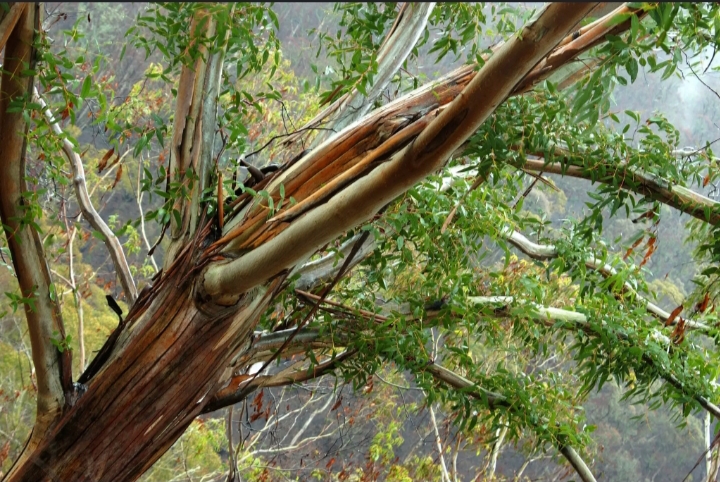
Scientific Name: Eucalyptus cypellocarpa
Other Names: Mountain grey gum, mountain gum, monkey gum or spotted mountain grey.
Size: This eucalyptus variety typically grows between 40 and 80 feet in height with a columnar habit.
Characteristics: A popular tree and one of the most versatile eucalypts. It has smooth white, grey or yellowish bark that is flakes in long ribbons. The leaves are curved, glossy-green on both sides whereas the flowers are produced in umbels of white, yellow, orange blooms in late summer. This tree won the prestigious Award of Garden Merit of the Royal Horticultural Society in 2002. It grows near seas level altitudes and in cool to warm environments.
Spinning Gum

Scientific Name: Eucalyptus perriniana
Size: Grows between 20 and 35 feet in height with an open spreading form.
Characteristics: This a small or tree with a shrubby form featuring a smooth, copper-colored bark which sometimes turns white, grey or green with time before being shed in short ribbons each year. The camphor-like scented leaves are bluish-green when juvenile and silver-green at maturity.
During spring and summer, creamy-white flowers emerge amongst the foliage. Spinning gum commonly grows in temperate areas, which are normally snow covered for several months in winter.
Plunkett Mallee
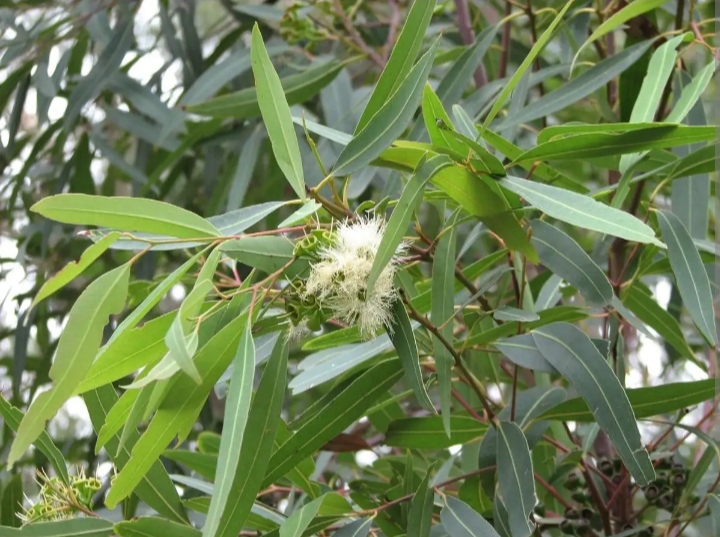
Scientific Name: Eucalyptus curtisii
Size: Plunkett Mallee typically ranges between 15 and 40 feet in height at maturity, depending with the growing conditions.
Characteristics: This eucalypt was named in 1931 from material collected in sandstone hills near Plunkett in Brisbane, Queensland. It is slender and generally small tree in size with glossy-green leaves and creamy-white flowers on branches.
The tree features a lignotuber-a swollen mass of woody tissue that occurs at ground level from which a number of thin stems arise. The bark is smooth, leaden grey to greenish-white and is shed in thin strips.
River Red Gum
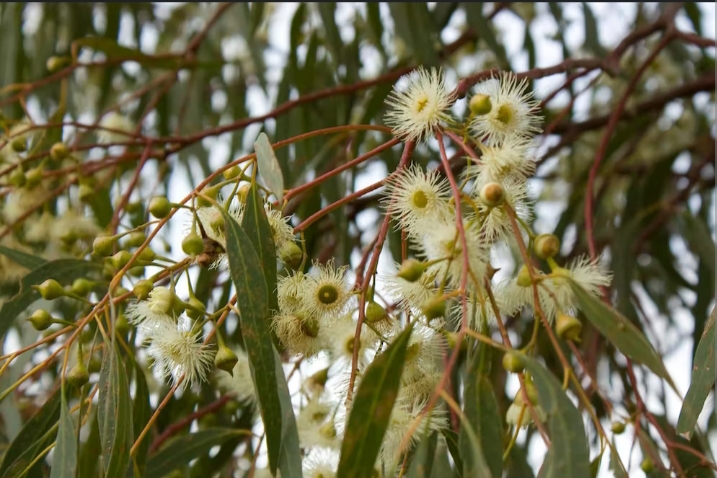
Scientific Name: Eucalyptus camaldulensis
Size: This is a medium-size tree growing between 40-80 feet tall with an open spreading crown.
Characteristics: River red gum is the most common of all eucalypts with ability to survive cold and drought. It is named for its heartwood which varies from pink to red. The mature leaves of this tree are dull green or greyish green whereas during summer its flowers are creamy-yellow or white. The bark is smooth, mottled white, yellowish-grey and shedding at intervals. There are often loose, rough slabs of bark near the base.
Alpine Ash
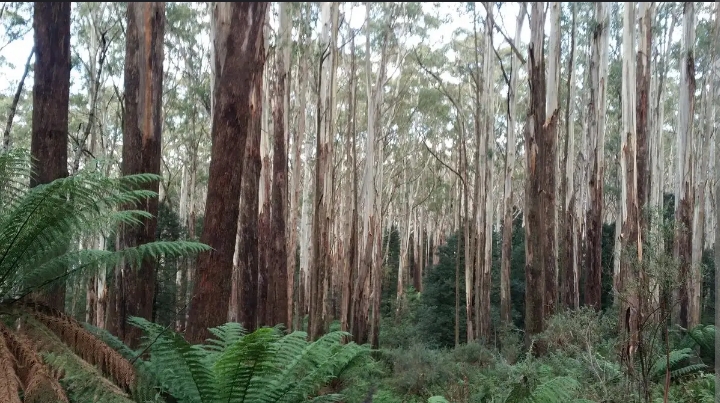
Scientific Name: Eucalyptus delegatensis
Other Names: Woollybutt, Gum-topped stringybark or White-top
Size: Alpine ash height ranges from 50-110 feet at maturity, sometimes 150 feet and forms a lignotuber.
Characteristics: Alpine ash’s crown is densely foliated with glossy green leaves. The bark is rough, grey and stringy on the lower half of the trunk. On mature trees, the bark sheds every year in flakes. Flowering occurs in spring to late summer. The flowers are generally white or cream-yellow. This tree is suitable for parks, arboretums and in homestead landscapes.
Shining Gum
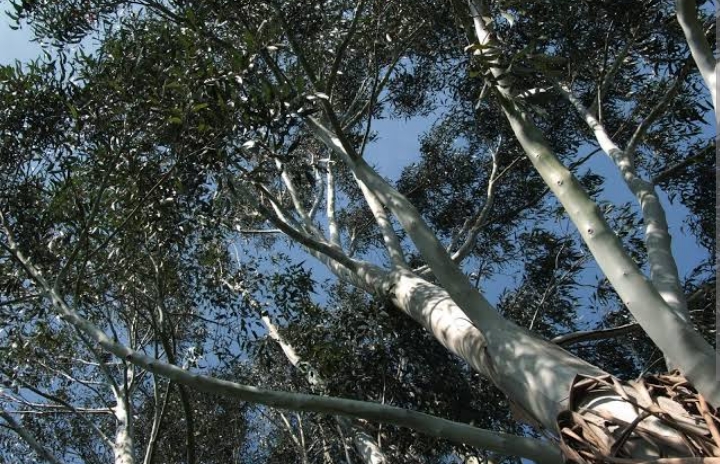
Scientific Name: Eucalyptus nitens
Other Names: Silvertop
Size: A mature shining gum tree towers between 70 and 120 feet with an open spreading crown.
Characteristics: This eucalypt is popular in very many places in UK, Australia and United States because of its versatility, interesting color and speckled appearance. It gets its name shining gum from the distinct glossy fruits, which have a varnished appearance as well as the leaves, buds and bark which also appear to shine. Its smooth white or grayish bark sheds in long ribbons every year. The wood is pale pink and straight grained.
Sydney Blue Gum
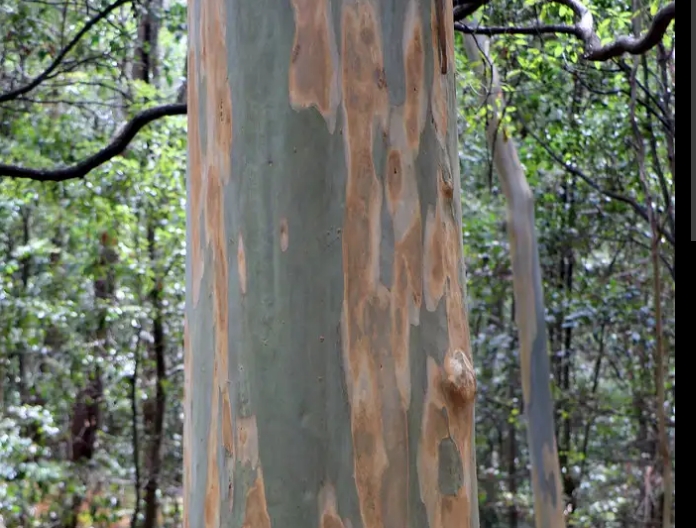
Scientific Name: Eucalyptus saligna
Other Name: Blue gum
Size: At maturity blue gum ranges between 60-110 feet tall.
Characteristics: This is a tree with a straight trunk and an open spreading crown foliated with glossy green leaves. The trunk has smooth paler grey or white bark, generally brownish near the base. The rough bark can cover up to 4 meters of the base of the trunk before thinning and shedding off the tree in long thin strips. The flowers are white and form axillary inflorescences which has clusters of 7 to 1o flowers.
Weeping Snow Gum
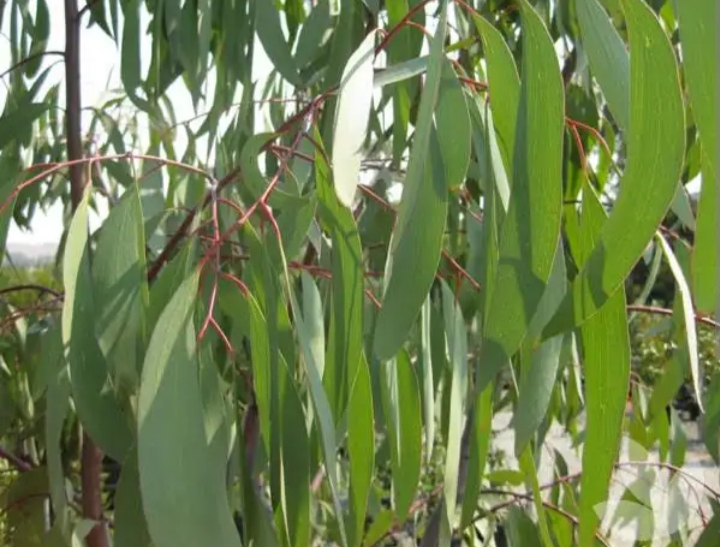
Scientific Name: Eucalyptus lacrimans
Other Names: Adaminaby snow gum
Size: In good conditions or its native state, weeping snow gum grow to between 8 and 15 meters in height.
Characteristics: This tree grows with distinctive slender pendulous branches and is densely foliated with shiny, grey-green leaves. The bark is powdery and smooth, white or grey in color. The trunks shade its bark in thin strips. Profuse flowering occurs from spring to early summer. The flowers are white. Its graceful and unique form and branching habit make it an excellent specimen tree for small spaces.
Ribbon Gum
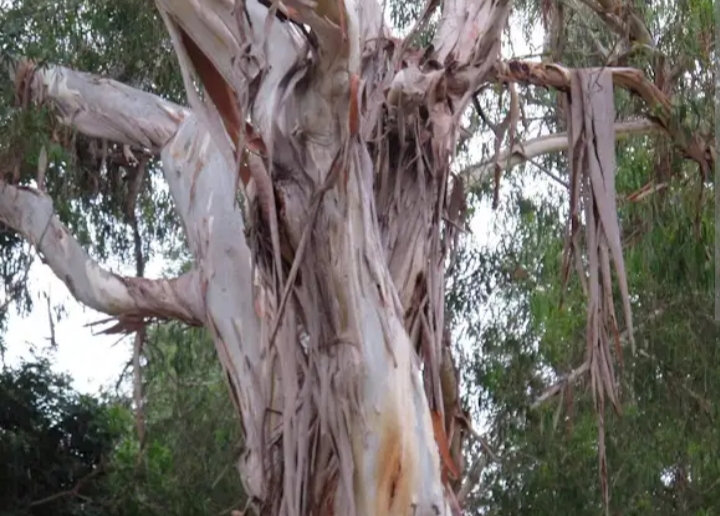
Scientific Name: Eucalyptus viminalis
Other Names: Manna gum, White gum or Ribbon gum
Size: Ribbon gum grows between 80-120 feet in its native state or favorable conditions.
Characteristics: This is a large tree with an open spreading crown adorned in glossy green leaves and creamy white flowers during spring to late summer. The trunk has smooth often powdery white to pale brown bark that is shed in long ribbons, sometimes hanging on the upper branches and sometimes with rough, fibrous bark near the base.
This eucalypt is good for shade, windbreaks or screening. It is also tolerant to heavy frost and snows and adaptable to any type of soil.
Advantages of Eucalyptus Trees
Advantages
- Once established, eucalyptus trees are drought tolerant and can survive extreme weather conditions.
- These trees do not lose their leaves in the autumn and therefore they provide reliable shade and attractive foliage throughout the year.
- Eucalyptus are disease and insect tolerant. In other words, they are not susceptible to many diseases and pests.
- They are fast growing.
- Eucalyptus trees do not require a lot of care once they’re established.
Disadvantages
- The leaves and roots of eucalyptus trees inhibit other plants from growing under them due to naturally-occurring chemicals.
- Eucalyptus are heavy consumers of water. According to U.S Department of Agriculture, a large eucalyptus tree consumes at least 0.5 liter of water per kilogram of its biomass.
- They grow many lateral roots up to 100 feet and therefore depletes the soil of nutrients rendering it unfit for any future productive use.
- They are prone to lightning strikes.
- They grow tall, making them unsuitable for small yards, near the house or in places where there are overhead electrical wires.
- Mature eucalyptus shade branches unexpectedly, which is very dangerous to people, cars and animals.
- They shed leaves throughout the year which them messy.
- They also shed their bark, which is highly flammable. In some areas, these trees have been blamed as the source of wildfires.